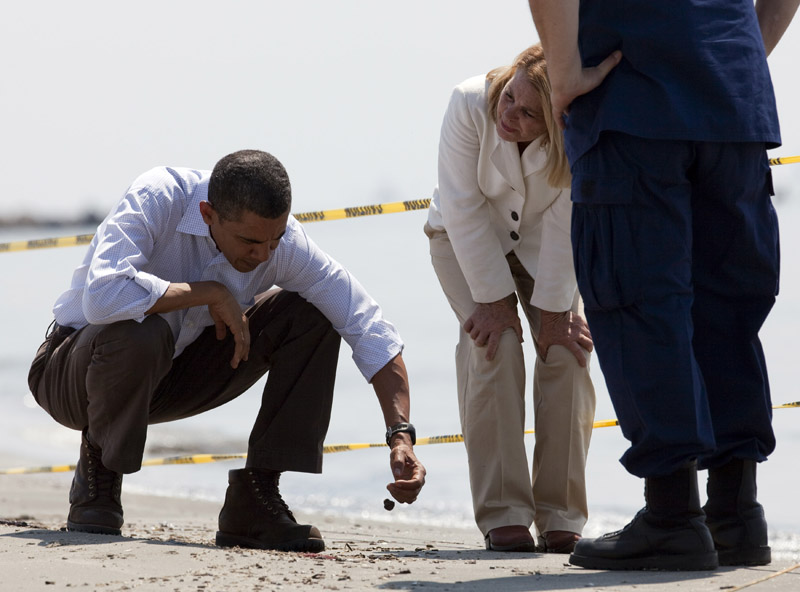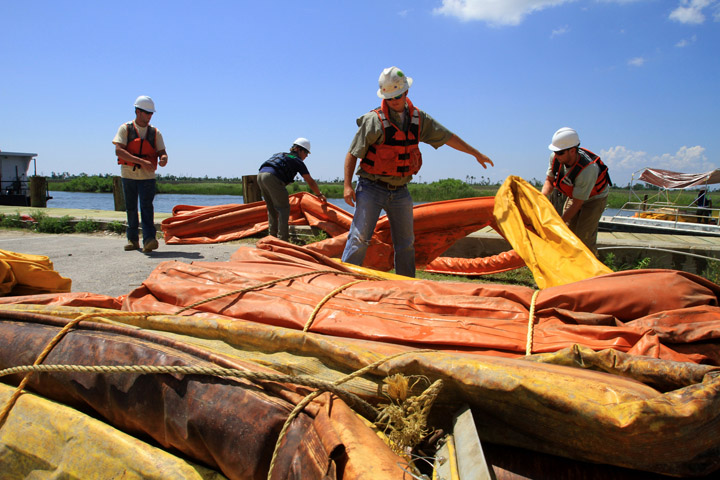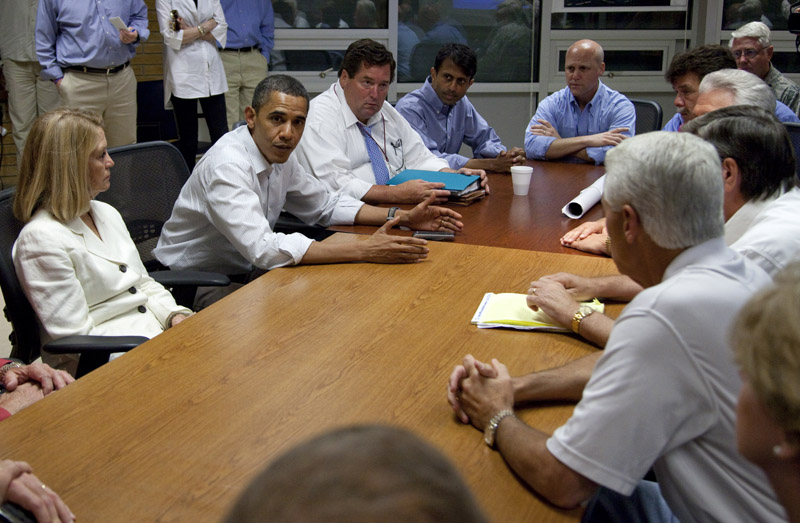COVINGTON, La. — BP kept pumping heavy mud into its blown-out well beneath the Gulf of Mexico today, but the company’s chief executive cautioned it will be two more days before anyone knows if the latest fix attempt will end the uncontrolled flow of crude that has already become the worst oil spill in U.S. history.
BP CEO Tony Hayward had projected a resolution to the so-called “top kill” as soon as Thursday afternoon, but an 18-hour delay in the injection of heavyweight mud scuttled those plans. Though engineers had stopped pumping hours earlier, BP and coast Guard officials assured the public Thursday morning that the process was going as planned.
Coast Guard Adm. Thad Allen said today that heavyweight mud was able to push down the oil and gas coming up at great force from underground, but it has not overwhelmed the gusher or stopped the flow.
President Barack Obama arrived in the Gulf, where he stood on Fourchon Beach in his shirt-sleeves and called reporters to the water’s edge to point out some small clumps of oil. The beach, one of the few sandy stretches along the Louisiana coast, was sealed off with crime-scene-style yellow tape.
“These are the tar balls that they’re talking about,” he said. “You can actually send out teams to pick up as they wash on shore.”
Today’s trip was the president’s second to the coast since the BP-leased oil rig Deepwater Horizon exploded April 20, killing 11 workers and triggering the spill.
He will be briefed in Grand Isle, La., where the beach has been closed since globs of oil started washing up a week ago.
Residents angry and frustrated over the slow pace of efforts to stop the leak did not expect the visit to change much.
“It’s a dog and pony show. What can he really do?” said Billy Ward, 53, who goes to Grand Isle with his family every weekend to stay in their beach house. “If he wants to do something, let him get out there and pump some mud and cement into that hole. Just fix it. Help us.”
The top kill is oil and gas giant BP PLC’s latest untested bid to end the spill that has, by the most conservative estimate, surpassed the Exxon Valdez disaster by gushing more than 18 million gallons into the Gulf. It has worked on land but never been tried 5,000 feet underwater, and Hayward gave it a 60 to 70 percent chance of success.
He said this morning the top kill was progressing as planned and BP engineers had completed a second phase by pumping what he called “loss prevention material” into a crippled piece of equipment known as a blowout preventer to form a bridge against which crews could pump more heavyweight mud.
“Clearly I’m as anxious as everyone in America is to get this thing done,” Hayward said.
If the top kill fails, BP’s next best hope for controlling even part of the leak is a tinier version of something that has already been tried: a steel containment box to cap the well. A 100-ton box lies junked on the ocean floor, abandoned by BP after ice-like crystals clogged it.
While BP officials say the smaller box shouldn’t have that problem, it’s clearly not their preferred method. It has been sitting in reserve on the seabed for more than a week while engineers first tried to siphon off oil through a mile-long tube.
That succeeded in collecting 924,000 gallons before crews took it out to allow room for the top kill attempt.
If the small box doesn’t work, BP officials say they will go back to the tube, crossing their fingers that a relief well still weeks away from being drilled far enough to affect the leak will help stop the bleeding.
And even that’s not a sure bet. Obama said Thursday that authorities insisted BP drill a second relief well as a backup since such wells often miss their mark.
BP said in a regulatory filing today that it has spent $930 million so far responding to the ruptured well, including costs for cleanup and prevention work, drilling relief wells, and paying grants to Gulf states, damage claims and federal costs. BP says it’s too early to quantify other potential costs and liabilities associated.
Two teams of scientists calculated the well has been spewing between 504,000 and more than a million gallons a day, which in the worst-case scenario means about 39 million gallons could have leaked.
The larger figure would be nearly four times the size of the Exxon Valdez disaster, in which a tanker ran aground in Alaska in 1989, spilling nearly 11 million gallons.
The new Gulf spill estimates released Thursday were far higher than the 210,000 gallons that BP and the Coast Guard had guessed was pouring from the well.
But even the highest estimate would not make the spill the biggest ever in the Gulf. In 1979, a drilling rig in Mexican waters – the Ixtoc I – blew up, releasing 140 million gallons of oil.
Send questions/comments to the editors.





Success. Please wait for the page to reload. If the page does not reload within 5 seconds, please refresh the page.
Enter your email and password to access comments.
Hi, to comment on stories you must . This profile is in addition to your subscription and website login.
Already have a commenting profile? .
Invalid username/password.
Please check your email to confirm and complete your registration.
Only subscribers are eligible to post comments. Please subscribe or login first for digital access. Here’s why.
Use the form below to reset your password. When you've submitted your account email, we will send an email with a reset code.